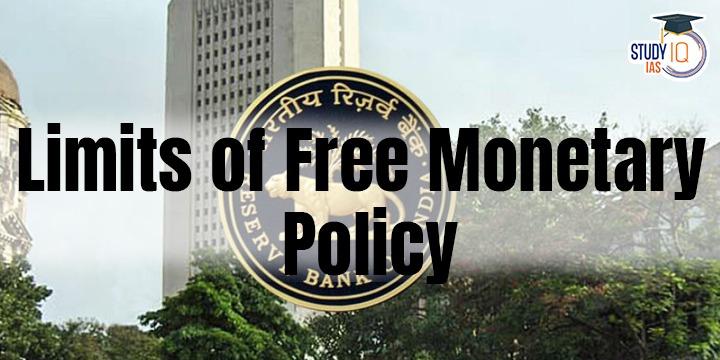Table of Contents
Free Monetary Policy: Highlight
- Since April 2019, inflation has exceeded 6% in as many as 21 months out of 41 months, since April 2019.
- India’s retail inflation surged to 7 percent on an annual basis in the month of August from 6.71 percent in July 2022.
- It is above RBI’s tolerance band of 2-6 percent for the eighth consecutive month in 2022.
- Headline inflation grew by 0.52 percent from 0.46 percent in July, 2022.
- Food inflation in August 2022 came in at 7.62 percent as against 6.75 percent in July.
Free Monetary Policy: Reason for Failure of RBI
- Weightage of food and beverage items in CPI: Food and beverage items have a combined weight of 45.86% in the overall CPI. Food inflation has been lower than CPI inflation in only 21 out of 41 months, since April 2019.
- High Food Inflation: CPI inflation has risen and overshot the 6% target, especially in recent months. This acceleration in inflation has been all the more for food inflation since late-2021. High rate of food inflation can be attributed to following factors:
- Imported Inflation: In December 2020, Russia announced export curbs on wheat, corn, barley, rye, sunflower and rapeseed for controling domestic inflation, leading to increase in Global Food Price.
- Increase in Edible oil Prices: Ukrainian drought, Russian export controls and pandemic-induced shortages of migrant workers in Malaysia’s oil palm plantations, increased global prices of edible oils and cereals.
- Indonesia imposing restrictions on palm oil shipments to contain local inflation, led to surge in edible oil inflation.
- Supply Side Inflation: Food inflation resulting from drought, unseasonal rains and heat waves have pushed local inflation rate in India.

- Losing Monetary policy independence: The high weight of food items in the Indian consumption basket and hence its CPI makes inflation less amenable to control through repo interest rate or cash reserve ratio hikes.
- Thus, the RBI has been forced to rely more on government action to meet inflation targets.
- Hence, instead of depending on monetary policy tools that seek to curb demand by raising borrowing costs for firms and consumers, RBI has to depend on “supply-side” measures by the government. This leads to monetary dependence on government.
- US rate Hike: It makes Rupee weaker, which is likely to make keep inflation at high level.
- Weak rupee makes imports costlier for a country that gets more than 85% of its oil requirements from outside India.
Free Monetary Policy: RBI and Inflation Targeting
- Section 45ZA of the RBI Act, 1934, has fixed the CPI inflation target at 4% with an “upper tolerance limit” of 6%.
- Section 45ZN of the RBI Act, 1934, mandate RBI to submit a report to the Centre on “the reasons for failure to achieve the inflation target” and “remedial actions proposed to be taken by the Bank”.
- Failure is defined as inflation being more than the upper tolerance level of the target “for any three consecutive quarters.
- Role of Monetary policy Committee: It is a statutory and institutionalized framework under the Reserve Bank of India Act, 1934, for maintaining price stability, while keeping in mind the objective of growth.
- The Governor of RBI is ex-officio Chairman of the committee.
- The MPC determines the policy interest rate (repo rate) required to achieve the inflation target (4%).
- It uses Consumer Price Index (CPI) data to control inflation.
Free Monetary Policy: Way Forward
- Insulate Monetary Policy from Food Inflation as seen in developed countries, where it weigh in range of 10-25%, which makes inflation more in control through repo interest rate or cash reserve ratio hikes.
- Coordination between government and RBI: Both need to work in tandem to control the spiraling inflation rate in the country. Some steps Taken by Government in controlling food Inflation:
- In the last one year, the effective import duty on crude and refined palm oil has come down from 30.25% and 41.25% to 5.5% and 13.75%, respectively.
- In May 2022, Government banned exports of wheat.
- In September 2022, exports of broken rice were prohibited
- In May 2022, sugar exports were moved from the “free” to “restricted” category.
Stats IQ
FDI in India
- India is on track to attract $100 billion in foreign direct investment (FDI).
- In 2021-22, the country received the “highest ever” foreign inflows of $83.6 billion.
- FDI has come from 101 countries, and invested across 31 union territories and states and 57 sectors in the country.
- Ease of Doing Business: To attract foreign investments, the government has put in place a liberal and transparent policy wherein most sectors are open to FDI under the automatic route.
- However, FDI equity inflows in India dipped by 6% to $16.6 billion during April-June, 2022.
About Foreign direct investment (FDI)
- It is when a company takes controlling ownership in a business entity in another country.
- With FDI, foreign companies are directly involved with day-to-day operations in the other country.
- This means they aren’t just bringing money with them, but also knowledge, skills and technology.
- FDI is an important monetary source for India’s economic development. Economic liberalisation started in India in the wake of the 1991 crisis and since then, FDI has steadily increased in the country.
























 WhatsApp
WhatsApp